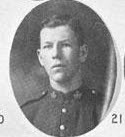 |
| Lieutenant Hugh Mariner Teed |
It was there, in Salisbury that Hugh met and married his wife, Violet May Stacy.
Over the next 3 years, the Battalion fought at Ypres, St. Julien, The Somme, Arras, Festubert and Pozieres. It was near Bruay, France that Hugh was killed in action and was buried in the Bruay Communal Cemetery Extension at Bruay, France.
Hugh was memorialized in the Chapel of Remembrance in Ottawa and also on his parent's graves in the Dorchester Cemetery, Dorchester New Brunswick.
Lieutenant Daniel Lionel Teed had served with the 5th Battery, Canadian Militia as a Captain, prior to enlisting in January 1916 in Fredericton, New Brunswick. His unit was the 36th Howitzer Battery, Canadian Corps, 9th Brigade, Canadian Field Artillery. He was with this regiment from its formation.
He appears to have been a respected officer and was considered to be a brave and clever man. During the Battle of Hill 70 in August 1917, Daniel's gallantry earned him the Military Cross. During this battle he was injured by a German chemical artillery shell that carried caustic substances that left the skin burnt and blistering.
On September 1, 1918 Daniel's unit was charged with clearing some German barbed wire in preparation for an impending attack. The battery was very exposed and came under artillery fire. A second volley of enemy shells fell short and as Lieutenant Teed ran to the next Howitzer to relay orders a shell struck the gun, killing Teed and two others instantly..
Daniel was laid to rest in the Monchy-le-Preux Military Cemetery nearby. Like his brother, his name can be found in the Chapel of Remembrance in the Parliament Buildings in Ottawa and on the tombstone of his parents in the Dorchester Cemetery, Dorchester, New Brunswick.









